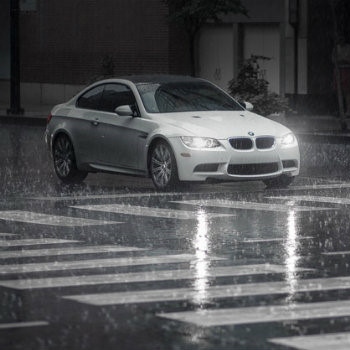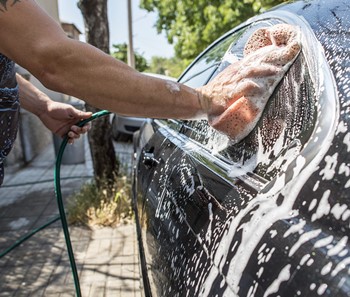Keeping your car clean is not only a matter of hygiene. Riding in a freshly-washed car has a special feeling to it, one that can be compared to rocking a new hairstyle, or a fresh shirt. However, a lot of people tend to base their car-washing schedule on the current weather – rain, to be exact. There is more to washing your car than just removing dust and mud, and an occasional gift left by a neighboring pigeon.
If you were wondering about washing your car before, during, or after rainfall, it is your lucky day, because I have your back. Different drivers have different car-cleaning habits, but one thing is certain – we all love a clean car. So, what is the big deal about washing the car before it rains, and should you maybe do it after? Let’s dig in and see the outcomes.
What Rain Does to Your Car?
 Regardless of the area you live in, from rural to urban, rainfall can leave a mark on your car. Some marks are visible right away, and these can usually be removed effortlessly. On the other hand, we have acidic rain droplets and other potentially harmful rainfalls. So, what gives?
Regardless of the area you live in, from rural to urban, rainfall can leave a mark on your car. Some marks are visible right away, and these can usually be removed effortlessly. On the other hand, we have acidic rain droplets and other potentially harmful rainfalls. So, what gives?
1. The Good
First of all, when it rains, your car will get a bit cleaner. That is if it stays out in the open. A summer shower will get rid of some nasty stuff like bird droppings, and bigger particles of dust, mud, and sand. If your car’s finish is protected, and the surface is polished with a car buffer, you shouldn’t worry about rain damaging the paint job. No one likes to scrape those pigeon presents off their hood, so the rain has your back on that one.
Another benefit of rainfall during the summer is, well, cooling. This may come off as a no-brainer, but sitting on a leather car seat in August is not a pleasant thing to do, so getting your car cooled off by rain droplets comes as a blessing.
Lastly, if you hate the blooming season as much as I do due to allergies, you will be glad to hear that rainfall actually washes off a large portion of pollen that sticks to your car while you ride.
As you can see, rainfall has its benefits as a natural car-wash. But no good thing comes for free, or at least without some risks.
2. The Bad
If rainfall was just good old water, I wouldn’t be talking about all of this at all. But, since the atmospheric waters bring along a large number of unwanted chemicals, we ought to learn how to protect the car’s surface.
The very first thing you can notice as soon as the car dries off after a rain shower is the smudges. In areas close to sandy surfaces, rain often carries the smallest dust and sand particles, and, you’ve guessed it – it delivers them to your car directly. If you are not sure whether or not there is sandy terrain in your state, just wait for the car to dry out after heavy rain. The smudges look like someone blotted the car paint with small, transparent, slightly-white stains.
Besides leaving removable dust marks, heavy rain can sometimes turn into hail. And, if hail isn’t something to worry about in your region, acidic rain certainly is.
3. The Ugly
The worst thing rainfall can do to your car isn’t staining it with dust or sand. As a matter of fact, the worst thing doesn’t include physical damage at all. It does, however, include slow, yet persistent, chemical harm.
Urban areas have significantly different atmospheric content. Industrial and traffic gas emissions dissolve into the humidity, thus making the rain acidic. One or two exposures to acidic rain won’t exactly hurt your car permanently, but the devil is in the details.
Constant exposure to acidic rain will expose the weak spots in the car’s paint job. One weak spot too many, and the (acidic) moisture starts getting under the surface level. I think you can see where all this leads if the cycle continues. People tend to undermine the effects of acidic rain. The tooth of time spears no one.
But, combating this is easy if you spend invest a bit of time into protecting your car’s surface with a protective layer, like car wax or a paint sealant. However, not addressing the issue will lead to corrosion and integral damages to the car’s structure. Not every metal car part is rust-resistant. That is why I insist on the old “an ounce of prevention is worth a pound of cure”.
Washing Your Car Before the Rain
If the weather forecast says it is going to rain, and your car is overdue for washing, you shouldn’t hesitate. Washing your car before it rains can do a lot of good to the paint job, especially if you use chemicals that coat and protect.
If you know for a fact that your area gets a lot of acidic rainfall, washing the car before should be a must. Once fall hits, and it rains more than it doesn’t, you will thank yourself for taking the proactive approach by protecting the car’s color, and ultimately integrity of the paint job.
The downside of washing your car before it rains is having to rinse off the sand and dust that might get stuck on the surface. All in all, washing the car before it rains is ok, as long as you don’t mind small and harmless stains after the car dries off.
Washing Your Car After the Rain
 The other side of this coin has its benefits as well. Washing your car after the raining stops can be done through two different methods:
The other side of this coin has its benefits as well. Washing your car after the raining stops can be done through two different methods:
- Washing a dry car – this means you just have to wait for the car to completely dry off. This way you can spot the dirtiest parts more easily, since these stains get more noticeable the longer they dry.
- Wash it while it’s wet – this method is more of a rinse then a wash and you should to it only if you plan to get your car under some sort of cover or the rain stopped completely.
The former gives you the option to protect your car from any damages rain might cause. I’d recommend this method to people who don’t have access to a garage or a parking spot that’s safe from the elements. Waterproof car covers are not as effective as you might think in the areas that get a lot of rain since they can keep the water in.
The latter is a method that takes less time, but it can all get ruined if it rains again. The rainwater gets the nasty stuff away, yes, but it leaves water and dust stains. Not to mention that you have to be sure that it won’t rain again until your car dries from the wash.
Should You Wash Your Car in The Rain?
The final question remains – should you wash the car before or after it rains? If you ask me, the ideal situation would be – both. Yes, this does sound like a lot of tedious work, but hear me out. If you don’t have access to a garage, or some sort of weather protection for your car, washing both before and after can be a lifesaver.
But, since no one has time to wash their car that much, I’d like to encourage you to stop for a moment and weight the options.
Take some time to research the climate of the region you live in. Try to figure out when does it rain the most and what time of year it barely rains. You could also ask around and see the contents of rainwater in your area. If it’s acidic, wash before, and take the prevention route. If the rain is on the less harmful side of things, well, you get to choose according to your schedule.
Both options have their upsides and downsides. One thing is certain, though – you must wash your car regularly. I am a strong proponent of washing your car as part of maintenance, not just as a means to make it look pretty.
How to Wash a Car – Some Tips and Tricks
 I would like to leave you with some general car washing tips. Although I won’t bother you with the general stuff, let me share some points I wish someone told me when I started taking care of my own car.
I would like to leave you with some general car washing tips. Although I won’t bother you with the general stuff, let me share some points I wish someone told me when I started taking care of my own car.
1. Use a multi-bucket system
Do not be afraid to use more than one bucket. Remember, you need to get as much dirt off the car’s surface as possible, and sticking a dirty washcloth or sponge into the car wash soap is a disaster. Use an additional bucket to clean the washing equipment.
2. Don’t forget the wheels
Cleaning your wheels and tires is also an important aspect of car washing. Always use a separate bucket for that and remember the secret ingredient – elbow grease. Dirty wheels lead to stuff getting under the cap, and potentially damaging the braking pads, or worse.
3. Headlights
Although it is not a common practice to use a headlight restoration kit every time, make it a habit to do it at least once in a few months. However, every car-washing session, you should scrub the dirt off of the headlights. Clear vision is one of the critically important aspects of road safety, and clear headlights will provide you just that.
4. Windows
Speaking of vision, remember to give the windows some love as well. The biggest focus should be on the windshield and the back window, but the door glass should be cleaned as well, at least once every third wash. Don’t forget the rearview mirrors, because they are as important, if not more important than some other glass surfaces.
Before You Go
Washing your car should be considered regular maintenance. You’d be surprised by how much trouble can be avoided by just keeping the car nice and clean. When rainfall gets into this equation, you get a real sense of good car hygiene. At least you should fight off rust, for starters.
I hope I brought this subject at least a tad bit closer to you. People often think about the rain as a free car wash, when in reality, there is much more to it. Rainwater can damage your car, and constant exposure to acidic rain can put some serious dents into the car’s health (and your wallet). Now go and give your 4-wheeled friend a good old wash. Stay safe and enjoy the road!